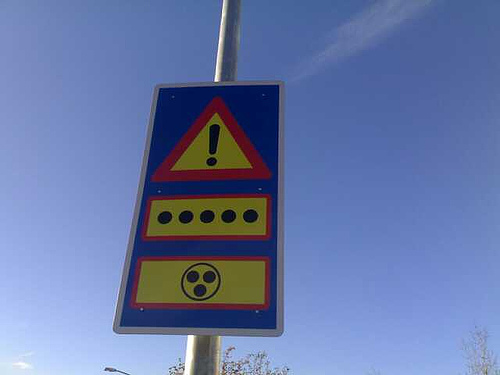
Icelandic sign warning of the presence of deaf and blind people on the road by sillygwailo
Nicomedes Flores from Voces Bolivianas blogging movement in Bolivia explains how Open Source Software designed for the visually impaired helps him communicate online with chatting, emailing and blogging. Meanwhile, in Ethiopia, an UNESCO and the International Telecommunication Union sponsored organization trains the blind and those with visual disabilities on how to use computers and communication technologies, and an employee and advocate of the ENOVIB network for the blind speaks to youth about how blindness can be an opportunity instead of a disability. Up to the North, in Spain, a designer comes up with videogames that visually impaired people can play, and posts demonstrations online, and in Nigeria and Canada, a woman blogs and vlogs about life as a deaf person who is rapidly losing her sight.
Nicomedes Flores is a Bolivian blogger who leads the Manuela Garandillas center for the blind in Cochabamba. Through his blog he makes the work the institution does known to the general population and on the following video, he tells us how Open Source Software makes it possible for him to surf the web, read and write emails and chat with others. The video has both English and Spanish subtitles thanks to DotSub.
This video by Itutelecommunication shows the beneficiaries of the computers, braille printers and voice synthesizers of the Adapted Technology Center for the Blind in Adis Ababa, Ethiopia:
Also in Ethiopia, Yetnebersh Nigussie arrives at the School for the Blind in Gondar and speaks to the students about how blindness has been an opportunity for her, and instead of holding her back, it has propelled her towards education and work, instead of an early marriage with back to back pregnancies. The video was produced by DarkandLight.org:
In Spain, Javier Mairena has designed a flash game that can be played by those with visual impairments. This “pong” style game uses sound cues to let the player know where the ball is headed. It can be downloaded here [es]. Following, a video demonstration of the game:
And last but not least, Coco, from Tactile the World tells the world what it is like to be deaf, and live with Usher's syndrome, which means that she will eventually lose her sight completely as well. Not only does she write a blog where she documents the ups and downs of her work in Nigeria helping with the curriculum of a Deaf-Blind School, but she also Vlogs, mixing advocacy, her adventures around the world trying to see as many things as she can before she completely loses her sight and a bit into the personal side of how she deals with her condition. She has transcribed some videos (which are in Sign Language), so that hearing people can read her transcripts, and so that blind people can have text the computer can read out loud to them, like this one, about her pet peeves (transcript available by following the previous link):
In her blog she also writes about Vlogging and the Deaf-Blind community, the need (or not) to caption or transcribe sign language videos, the importance of having a community, communicating between the deaf community and the deaf-blind community and some of the challenges being Deaf-blind presents:
More instances: Walmart just introduced speakers on debit-card machines by the cashier so that the hearing blind could listen and do their own checkouts. The same goes for millions of ATMs – there is Braille but no popup braille displays to replace the voice so that the Deaf Blind could read. To cross the street is a challenge for the Deaf Blind as there’s no vibrator visibly everywhere where it should be, but there’s of course the voiced warnings when the hand flashes or the white man’s flashing. Walk! Walk! Stop! Stop!
Food for thought.







1 comment
I think this is so great that he created this. It gives the visually impaired a way to communicate quickly and doesn’t restrict them. I think that this is the beginning of more great ideas to hopefully come in the future. It definately allows visually impaired to express themselves.